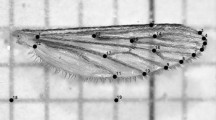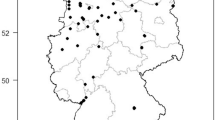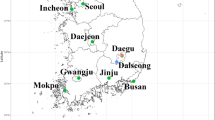Abstract
The probabilistic approach was applied to morphometric identification of Culex pipiens pipiens / torrentium mosquito females collected in the Sablino caves (Leningrad Province of Russia). The distances between landmarks of the radial wing veins r(2+3) and r3 were measured, and the frequency distribution of the r(2+3) / r3 wing vein index was analyzed. The obtained distribution had two maxima coinciding with the distribution maxima obtained earlier by other authors for the German populations of Culex pipiens pipiens and C. torrentium. Most specimens in the sample from the Sablino caves grouped at the maximum of the Culex pipiens normal distribution. We propose to use the Bayes factor (BF) to select those mosquito females which most likely belong to C. p. pipiens. In the sample studied, the BF value was greater than 10 for 72.5% of the specimens, which was interpreted as strong or very strong evidence in favor of C. p. pipiens. For 16.5% of individuals the BF value was greater than 0.1 and smaller than 10, providing moderate or weak evidence in favor of one of the two species. Overall, 11% of the females had BF values smaller than 0.1, this being strong or very strong evidence in favor of C. torrentium. To increase the reliability of C. p. pipiens selection, the specimens with the highest BF values should be chosen.




Similar content being viewed by others
REFERENCES
Becker, N., Petrić, D., Zgomba, M., Boase, C., Dahl, C., Lane, J., and Kaiser, A., Mosquitoes and Their Control, 2nd Edn, Berlin: Springer, 2010.
Becker, N., Jöst, A., and Weitzel, T., The Culex pipiens complex in Europe, J. Am. Mosq. Control Assoc., 2012, vol. 28, p. 53.
Börstler, J., Lühken, R., Rudolf, M., Steinke, S., Melaun, C., Becker, S., Garms, R., and Krüger, A., The use of morphometric wing characters to discriminate female Culex pipiens and Culex torrentium, J. Vector Ecol., 2014, vol. 39, no. 1, p. 204.
Börstler, J., Jöst, H., Garms, R., Krüger, A., Tannich, E., Becker, N., Schmidt-Chanasit, J., and Lühken, R., Host-feeding patterns of mosquito species in Germany, Parasites Vectors, 2016, vol. 9, no. 1, p. 318.
Dahl, C., Taxonomic studies on Culex pipiens and C. torrentium, in Biosystematics of Haematophagous Insects. Oxford Systematics Association Special Volume 37, Service, M.W., Ed., Oxford: Clarendon Press, 1988, p. 149.
Dobrotworsky, N.V., The problem of the Culex pipiens complex in the South Pacific (including Australia), Bull. W.H.O., 1967, vol. 37, p. 251.
Fedorova, M.V. and Shaikevich, E.V., Morphological and molecular-genetic distinctions between adult mosquitoes Culex torrentium Martini and C. pipiens Linnaeus (Diptera, Culicidae) from Moscow Province, Entomol. Rev., 2007, vol. 87, p. 127.
Gutsevich, A.V., Monchadsky, A.S., and Stackelberg, A.A., Fauna SSSR. Nasekomye dvukrylye (Fauna of the USSR. Insecta, Diptera), Vol. 3, Issue 4: Komary sem. Culicidae (Mosquitoes, Family Culicidae), Leningrad: Nauka, 1970.
Harbach, R.E., Harrison, B.A., and Gad, A.M., Culex (Culex) molestus Forskal (Diptera: Culicidae): neotype designation, description, variation, and taxonomic status, Proc. Entomol. Soc. Wash., 1984, vol. 86, p. 521.
Hesson, J.C., Verner-Carlsson, J., Larsson, A., Ahmed, R., Lundkvist, A., and Lundström, J.O., Culex torrentium mosquito role as major enzootic vector defined by rate of Sindbis virus infection, Sweden, 2009, Emerging Infect. Dis., 2015, vol. 21, p. 875.
Hesson, J.C., Rettich, F., Merdic, E., Vignjevic, G., Ostman, O., Schäfer, M., Schaffner, F., Foussadier, R., Besnard, G., Medlock, J., Scholte, E.J., and Lundström, J.O., The arbovirus vector Culex torrentium is more prevalent than Culex pipiens in northern and central Europe, Med. Vet. Entomol., 2014, vol. 28, p. 179.
Jaenson, T.G., Overwintering of Culex mosquitoes in Sweden and their potential as reservoirs of human pathogens, Med. Vet. Entomol., 1987, vol. 1, no. 2, p. 151.
Jarosz, A.F. and Wiley, J., What are the odds? A practical guide to computing and reporting Bayes factors, J. Probl. Solving, 2014, vol. 7, p. 2.
Kass, R.E. and Raftery, A.E., Bayes factors, J. Am. Stat. Assoc., 1995, vol. 90, no. 430, p. 773.
Khalin, A.V. and Aibulatov, S.V., Fauna of blood-sucking insects of the gnus complex in the Northwestern region of Russia. III. Mosquitoes (Culicidae), Parazitologiya, 2019, vol. 53, no. 4, p. 307.
Leggewie, M., Badusche, M., Rudolf, M., Jansen, S., Börstler, J., Krumkamp, R., Huber, K., Krüger, A., Schmidt-Chanasit, J., Tannich, E., and Becker, S.C., Culex pipiens and Culex torrentium populations from Central Europe are susceptible to West Nile virus infection, One Health, 2016, vol. 2, p. 88.
Lundström, J.O., Mosquito-borne viruses in Western Europe: a review, J. Vector Ecol., 1999, vol. 24, p. 1.
Lundström, J.O., Niklasson, B., and Francy, D.B., Swedish Culex torrentium and Cx. pipiens (Diptera: Culicidae) as experimental vectors of Ockelbo virus, J. Med. Entomol., 1990, vol. 27, p. 561.
Natvig, L.R., Contributions to the knowledge of the Danish and Fennoscandian mosquitoes. Culicini, Norsk Entomol. Tidsskr., 1948, Suppl. 1.
R Core Team, R: A Language and Environment for Statistical Computing, Vienna: R Foundation for Statistical Computing, 2017. https://www.R-project.org/.
Ribeiro, H. and Ramos, H.C., Identification keys of the mosquitoes (Diptera, Culicidae) of continental Portugal, Açores and Madeira, Eur. Mosq. Bull., 1999, vol. 3, p. 1.
Service, M.W., The taxonomy and biology of two sympatric sibling species of Culex, C. pipiens and C. torrentium (Diptera, Culicidae), J. Zool., 1968, vol. 156, p. 313.
Sirivanakarn, S., Medical entomology studies – III. A revi-sion of the subgenus Culex in the Oriental Region (Diptera: Culicidae), Contrib. Am. Entomol. Inst., 1976, vol. 12, no. 2, p. 1.
Vinogradova, E.B., Komary kompleksa Culex pipiens Rossii (Mosquitoes of the Culex pipiens Complex in Russia), St. Petersburg: Ross. Akad. Nauk, 1997.
WRBU (Walter Reed Biosystematics Unit), Systematic Catalog of Culicidae. http://mosquitocatalog.org/
ACKNOWLEDGMENTS
The authors are grateful to A.V. Khalin and S.V. Aibulatov (Zoological Institute, Russian Academy of Sciences) for help during preparation of this paper.
Author information
Authors and Affiliations
Corresponding author
Ethics declarations
The authors declare that they have no conflict of interest. All applicable international, national, and/or institutional guidelines for the care and use of animals were followed. All procedures performed in studies involving animals were in accordance with the ethical standards of the institution or practice at which the studies were conducted.
Rights and permissions
About this article
Cite this article
Razygraev, A.V., Sulesco, T.M. The Use of the Bayes Factor for Identification of Culex pipiens and C. torrentium (Diptera: Culicidae) Based on Morphometric Wing Characters. Entmol. Rev. 100, 220–227 (2020). https://doi.org/10.1134/S0013873820020104
Received:
Revised:
Accepted:
Published:
Issue Date:
DOI: https://doi.org/10.1134/S0013873820020104




